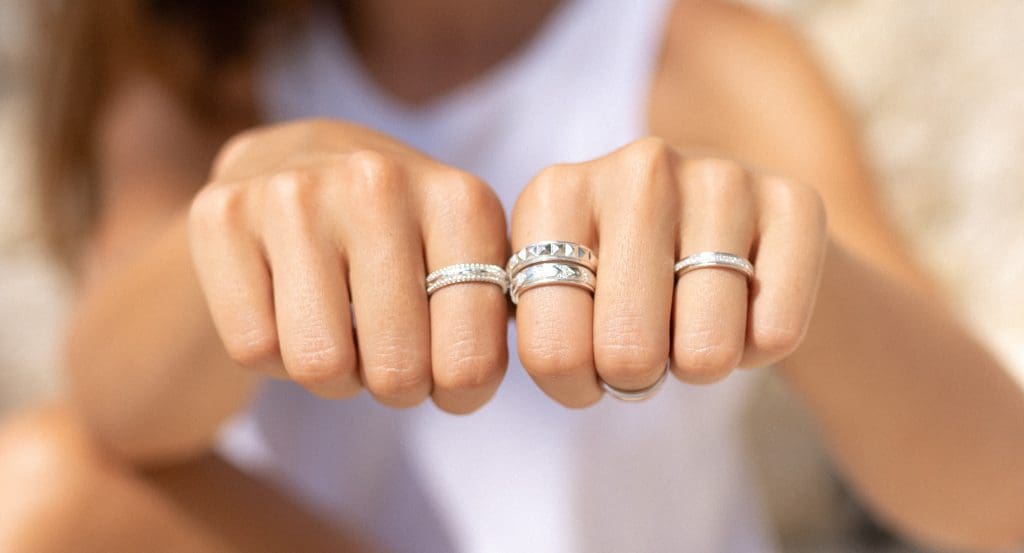Full Disclosure: Clicking on these links could mean a tiny commission for me, at no extra cost to you.
Ever find yourself tapping your fingers, bouncing your knee, absentmindedly twirling your anxiety ring? While fidgeting has gotten a bad rap and is often dismissed as a bad habit, research suggests it has many surprising benefits especially for your mental health. From reducing anxiety to improving focus, the fidgeting benefits are definitely worth getting your hands on. Whether you use a fidget ring, a worry stone or another fidget toy, making those small repeated movements can be your key to releasing anxious energy, boosting mindfulness and calming your mind and body. nervous energy, boost mindfulness, and even enhance productivity.
The Science Behind Fidgeting: Why Do We Do It?
Fidgeting is the body’s way of self-regulating emotions, maintaining focus, and relieving stress. Studies show that small repetitive movements can:
- Lower cortisol levels, reducing stress and anxiety.
- Boost dopamine and norepinephrine, improving focus and concentration.
- Help with sensory processing, especially for individuals with ADHD or autism.
- Improve circulation and energy levels, preventing fatigue during long periods of sitting.
Many people naturally fidget when they are anxious, overwhelmed, or trying to concentrate. Rather than fighting the habit, using fidget rings, anxiety rings, or spinner rings can help turn unconscious movements into a purposeful, calming action.
Here are some of the top reasons people fidget:
- Boredom
- Lack of Focus
- Stress and Anxiety
- Regulation of Attention
- Habituation
- Sensory Needs
- Physical Discomfort
- Genetic Predisposition
- Mental Health Conditions
The Mental Health Benefits of Fidgeting
Fidgeting is a natural way the body regulates stress, maintains focus, and enhances cognitive function. Whether it’s spinning a fidget ring, tapping your fingers, or using a worry stone, small movements can have a powerful impact on mental well-being.
Here’s a deeper look at how fidgeting benefits anxiety relief, focus, emotional regulation, and overall mental health.
1. Reduces Anxiety and Stress
One of the most well-known fidgeting benefits is its ability to ease stress and anxiety. Fidgeting provides a physical outlet for nervous energy, helping people feel more in control.
- Helps regulate cortisol levels, reducing stress responses
- Serves as a grounding technique, bringing attention back to the present moment
- Encourages rhythmic, meditative movement, similar to breathing exercises
Many people who experience social anxiety or panic attacks find comfort in using fidget rings for anxiety as a subtle coping mechanism.
2. Improves Focus and Cognitive Function
Fidgeting can enhance concentration, especially for those who struggle to stay engaged in tasks.
- Keeps the brain engaged by providing just enough stimulation
- Prevents mental fatigue during long periods of sitting or studying
- Enhances problem-solving and creative thinking
This is particularly beneficial for individuals with ADHD, as structured fidgeting, such as using a spinner ring or crystals for anxiety, helps maintain focus.
3. Helps Break Unhealthy Habits
Fidgeting can serve as a replacement for compulsive behaviors, such as:
- Nail-biting
- Skin-picking (dermatillomania)
- Hair-pulling (trichotillomania)
- Lip-chewing
Using a fidget ring, worry stone, or fidget toy provides a healthier alternative to these habits, offering a way to redirect nervous energy.
4. Supports Emotional Regulation
Fidgeting can help individuals process emotions and prevent emotional overload.
- Encourages self-awareness by providing a structured movement
- Reduces frustration and restlessness
- Promotes relaxation, similar to crystals for anxiety or mindfulness exercises
This is why many self-care gift sets and wellness gift baskets include fidget rings, worry stones, and crystals for healing.
5. Increases Productivity
Fidgeting can enhance work performance by preventing distraction and regulating energy levels.
- Allows for controlled movement, which can boost engagement
- Helps prevent burnout during long work or study sessions
- Improves information retention and learning
For professionals and students, fidgeting can be an effective way to stay focused when used in moderation. Tools such as spinner rings provide a subtle method for maintaining productivity.
6. Provides Sensory Stimulation for Neurodivergent Individuals
Fidgeting is especially beneficial for individuals with autism, ADHD, or sensory processing disorders.
- Provides tactile feedback, which can be calming
- Helps prevent overstimulation by offering a controlled sensory experience
- Allows for self-regulation in high-stimulation environments
This is why mental health products, anxiety relief gifts, and self-care items for women and men often include fidget tools.
7. Aids in Sleep and Relaxation
Fidgeting before bed can help transition the brain into relaxation mode.
- Spinning a fidget ring or using a worry stone can serve as a nighttime relaxation ritual
- Pairing fidgeting with deep breathing can promote better sleep
- Holding a crystal fidget ring or healing stone can provide a sense of security before bed
For those dealing with nighttime anxiety or insomnia, incorporating relaxation gifts, self-care items, or wellness products into an evening routine can improve sleep quality.
Shop Our Wellness Collection
Looking to bring more calm and mindfulness into your daily life? The Anxiety Gone Shop is your go-to destination for handpicked mental wellness and self-care tools that soothe, support, and empower.
From anxiety-easing fidget rings to soulful self-care products, you’ll find everything you need to relax and restore. Take the first step toward a calmer, more centered you today.
How to Incorporate Fidgeting into Daily Life
There are many ways to use fidgeting as a tool for better mental health.
- Wear a fidget ring – Keep a spinner ring on your finger to use whenever you feel anxious or distracted.
- Use a worry stone – Carry a healing stone in your pocket and rub it for stress relief.
- Take movement breaks – Incorporate physical activity to prevent restlessness.
- Practice mindful fidgeting – Pair fidgeting with deep breathing or meditation.
- Create a fidget-friendly workspace – Keep anxiety rings, therapy gifts, and relaxation tools nearby.
By making fidgeting an intentional habit, individuals can use it as a tool for improved focus, stress relief, and emotional regulation.
Best Fidget Tools for Anxiety Relief and Focus
Fidget rings are one of the most popular tools for stress relief and anxiety management. Many people prefer gold fidget rings, sterling silver fidget rings, and anxiety jewelry for both function and fashion. Gemstones for anxiety relief, or whatever purpose your fidgeting is serving, can also be incredible beneficial. Here are some popular options:
- Spinner rings – Rotating bands provide a soothing spinning motion
- Worry stones – Textured surfaces offer a tactile sensory experience
- Gemstone fidget rings – Infused with crystals for healing like amethyst or rose quartz
- Amethyst (calming energy)
- Rose Quartz (self-love and stress relief)
- Black Tourmaline (protection from negative energy)
Is Fidgeting Bad?
Fidgeting is usually a harmless response to stress or boredom, but it can also signal underlying health issues. Some repetitive movements may indicate medical conditions. For example, constantly moving your legs to relieve discomfort could be a sign of restless leg syndrome. Other forms of fidgeting, like skin picking or hair pulling, may be recognized as medical problems. Additionally, tremors and other involuntary movements that resemble fidgeting can be caused by neurological issues.
People who fidget a lot are more likely to experience mind wandering and daydreaming. When your mind drifts, you tend to fidget more, which can negatively impact your performance on tasks because you’re not fully paying attention. However, while fidgeting may indicate a problem with attention, it might also be a solution to improving focus. Fidgeting can provide the physiological stimulation your body needs to bring energy and attention back to an optimal level, helping you concentrate on the task at hand.
Examples of Unhelpful Fidgeting
Despite the potential benefits of fidgeting, society often views it negatively. Fidgety individuals are usually viewed as bored, frustrated, or have attention issues. Additionally, fidgety movements can distract others. So, it’s important to recognize when it might be doing more harm than good.
Here are some examples of unhelpful or disruptive fidgeting:
- Excessive leg shaking
- Loud finger tapping
- Repeatedly clicking a pen
- Twirling hair excessively
- Nail-biting, skin-picking, or hair-pulling
Distraction to Others
In environments like meetings, classrooms, or shared workspaces, certain fidget behaviors (e.g., clicking a pen, tapping a foot loudly) can be distracting to those around you. It’s crucial to be mindful of your surroundings and choose fidget tools and methods that are quiet and unobtrusive.
Overstimulation
Excessive or vigorous fidgeting can sometimes indicate higher levels of anxiety and may exacerbate stress rather than alleviate it. If you find that your fidgety movements are becoming frantic or compulsive, it might be a sign to take a break and practice more calming activities like deep breathing or meditation.
Physical Harm
Habits like nail-biting, skin-picking, or hair-pulling can lead to physical discomfort or injury over time. These behaviors are often signs of deeper anxiety and may require alternative coping strategies or professional support to manage effectively.
Examples of Helpful Fidgeting
- Using a stress ball
- Spinning a fidget ring
- Gently tapping fingers
- Playing with a fidget spinner

Strategies to Promote Helpful Fidgeting
There isn’t a one-size-fits-all treatment to stop fidgeting since the act is often unconscious. Rather than trying to eliminate them altogether, it’s more effective to harness it into controlled movements that can actually increase your focus.
The first step in harnessing your fidgety habits is to identify the specific movements you tend to make. Once you’ve identified them, you can follow these general principles to channel them productively:
1. Use Specific Tools to Target Fidget Habits
Depending on whether you fidget with your hands, feet, or whole body, there are specific tools designed to target each area. For instance, stress balls and fidget rings are great for hand fidgeting, while a foot roller can help if you tend to fidget with your feet. If you fidget with multiple body parts simultaneously, using multiple tools at once might be beneficial.
2. Ensure the Movement Doesn’t Affect Visual or Auditory Focus
Whatever fidget tool you use, it should allow you to stay engaged with your task without causing distractions. For example, using a silent fidget spinner or a non-clicking pen can help you fidget without creating noise that could disrupt your focus or that of those around you.
3. Avoid Overly Stimulating Fidget Toys
The fidget tools you choose should not be so exciting or entertaining that they divert your attention away from your task. The goal is to find a balance where the tool provides just enough sensory input to help you concentrate without becoming a distraction in itself.
4. Choose Helpful Fidget Tools
Fidget tools, such as fidget rings, stress balls, and spinners, are designed to provide sensory input and promote helpful fidgeting. These tools can help channel restless energy into productive movements.
Fidget rings are an excellent tool for promoting helpful fidgeting. They are discreet, stylish, and provide a subtle way to keep your hands busy. Our collection of high quality silver and gold fidget rings are designed to offer the perfect balance between functionality and aesthetics.
There are also fidget cubes, fidget spinners and of course, a classic fidget tool: the stress ball. All of these can help reduce nervousness and improve focus.
5. Incorporate Mindfulness Practices
Incorporating mindfulness practices can help you become more aware of your fidgeting habits and make conscious choices about how and when to fidget. Techniques like deep breathing and meditation can enhance the fidgeting experience and the benefits they offer.
Conclusion
Fidgeting can be both unhelpful and helpful, depending on how it’s managed. By understanding the difference and using the right tools, you can harness the power of fidgeting to improve focus, reduce anxiety, and enhance cognitive function.
Our collection of fidget rings offers a stylish and effective way to channel your fidgeting positively. These rings are designed to be discreet and functional, allowing you to fidget without drawing attention or causing distractions. Explore our collection and find the perfect fidget ring to suit your needs, and turn your fidgeting into a powerful tool for better concentration and stress relief.
Frequently Asked Questions
- What is the difference between unhelpful and helpful fidgeting?
Unhelpful fidgeting distracts and disrupts, while the opposite aids concentration and reduces stress. - How can fidgeting improve focus?
Fidgeting provides sensory input that keeps the brain engaged, preventing the mind from wandering during tasks. - Are fidget rings effective for managing anxiety?
Yes, fidget rings can help manage anxiety by providing a calming tactile experience. - What are some popular fidget tools?
Popular fidget tools include fidget rings, stress balls, and fidget spinners. - How do I choose the right fidget ring?
Choose a fidget ring that fits comfortably and suits your style. Consider the design and material for optimal comfort and functionality.
Additional Resources
At Anxiety Gone, we believe in healing together. We’ve partnered with trusted wellness organizations to bring you the most effective tools, insights, and support. Some links may earn us a commission — always at no extra cost to you.
Join The Club
Connect with our private self-care community for daily support, exclusive tips, and inspiration. Join us today
Talk Therapy
Get matched with licensed therapists online through BetterHelp and begin your healing today. Start now
Hims/Hers
Receive personalized, affordable mental health care + medication from home — no insurance required. Learn more
Mental Health, Right to your Inbox
Subscribe to our newsletter for a place to rest your mental health and find ways to support your journey. Sign up
Emotional Freedom Technique
Tap your way to calm with scientifically backed stress relief. Our readers receive a 14-day free trial! Try EFT now
Mindfulness App
Access 2,000+ guided practices to support your mental health wherever you are + exclusive discount when you upgrade Try it
Online Breathwork
Experience calm and reset your nervous system with guided sessions and receive your first month free . Get started
Find a Helpline
If you need immediate support, visit our directory to find help near you. See helplines








